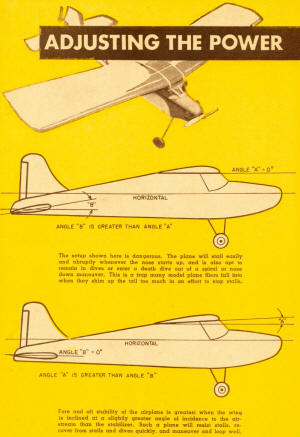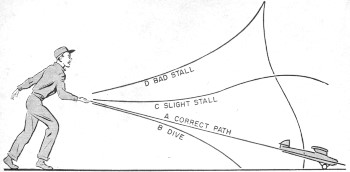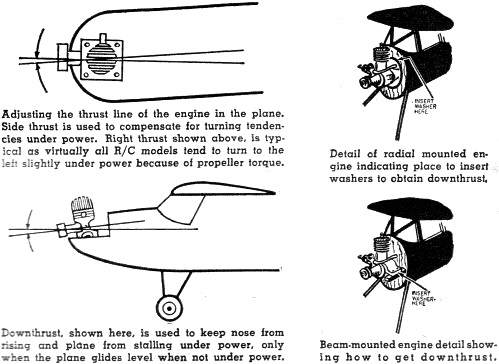 [Table of Contents]
[Table of Contents]People
old and young enjoy waxing nostalgic about and learning some of the history of
early electronics. Popular Electronics was published from October 1954 through April 1985. All copyrights (if any) are
hereby acknowledged.
See
Popular Electronics articles
on aircraft modeling. See all articles from
Popular Electronics.
|
If you ever had any doubt whether Bill Winter was one of the model airplane hobby's
earliest and most prolific contributors, check out this article that appeared in
the January 1955 edition of Popular Electronics magazine (only the
third issue since its inception). Radio control systems were just
beginning to be commercialized and priced at a point where a lot of the public could
afford it. Quirks and high unreliability that plagued early systems had become less
of an issue so that airplane and power plant design efforts could take priority
with aeromodelers. In this article, Bill addresses setting proper wing incidence
and engine thrust angles for good, repeatable, stable flight.
Adjusting the Power R/C Plane
By William Winter, Editor, "Model Airplane News"
You can avoid a lot of grief and lost airplanes if you will follow the
practical hints for adjusting and flying your R/C plane given here.
 Beginners launching their powered airplane
models on their first flights make two mistakes. One is to use too much or too little
power, and the other, often the fatal one, is to use too much fuel or too long an
engine run. Beginners launching their powered airplane
models on their first flights make two mistakes. One is to use too much or too little
power, and the other, often the fatal one, is to use too much fuel or too long an
engine run.
It is possible for the plane to fly erratically and finally, uncontrollably,
on an early test flight, and still remain in the air to drift away and be lost.
Test flights should be short. The amount of power is most easily controlled by opening
up the needle valve for a rich mixture, recognized by a smoky exhaust. This assumes
that the engine uses a glow plug. If it is a diesel engine, back off the head to
obtain a rich mixture; for ignition engines, retard the spark. It is hard to say
exactly what power would be required but, if one had to guess, about two-thirds
would be best under average conditions.
Another possibility is to place the propeller on backwards, letting the engine
"rev up." This cuts effective thrust by a third or more.
Before attempting to fly the plane, run off a measured amount of fuel and time
the engine run. You don't want more than a minute, and remember, if you decide to
lean out the needle valve the same amount of fuel may double the engine run. A fuel
shut-off device is desirable for first tests; back up the device with a limited
amount of fuel.
There are many pros and cons as to whether the radio should be operative on a
beginner's first test flight. Chances are the radio will be a help.
We'll assume that you have made the necessary ground checks, flight checks, etc.
Holding the plane as described in last month's article, run at a moderate speed
(a very slow run if the plane is light and there is any wind) into the wind. When
lift is felt, push the plane forward as you release it, with the nose ever so slightly
above the horizon. You should follow through and use a smooth technique, the same
as you would in golf.
While it is essential to handle glide and power-on adjustments separately, it
is not always possible to distinguish between the two in a short first test flight,
especially under exciting circumstances. However, if the plane is high enough to
glide when the engine stops, try to remember whether it glides too slowly, stalling
or appearing to "mush" or falter; or whether it seems to dive ever so slightly.
Did it want to turn of its own accord?

Observe very carefully how the plane behaves during its first hand-launched glide.
The proper glide path is straight. smooth, and without dips until the plane strikes
on wheels. If the plane dives slightly (B), increase the angle that the wing makes
with the airstream, or decrease the angle of the stabilizer. In severe cases, move
the weights in the plane backwards. If the plane stalls (C) or (D), increase the
positive angle of the tail, or move weights forward. Be certain when you launch
the plane that you do not throw it nose up, or too fast, especially in high winds,
as this will produce a false stall, giving you an incorrect idea of the model's
performance.
Continue to refine the adjustments begun in the hand glide tests, described in
last month's article. It is essential to work out glide trim first, if at all possible.
If the plane was not in danger of cracking up or getting out of control under power,
ignore, for the time being, the power-on adjustments and perfect the glide trim.
But if the ship was in danger under power, take the bull by the horns and affect
any adjustment that will enable you to get it into the air well enough to observe
and evaluate its performance. For example, if the plane turns wildly to the left
under power, skimming the ground, adjust the rudder slightly to the right (perhaps
1/16 inch on a small plane, 1/8 inch on a large one). If the plane turns to the
right, use left rudder. Naturally, rudder adjustments affect the glide path, but
the thrust line (an imaginary line drawn through and parallel to the shaft of the
engine) can be offset to one side or the other on subsequent flights, at which time
the rudder would be readjusted to normal. Everything is aimed at getting a look
at the glide.
Thrust Line
After the glide is reasonably correct, begin to make thrust line adjustments
on subsequent short flights, tilting the engine up or down, left or right, as required
to offset the model's power-on tendencies.
If the plane turns under power to the left, the thrust line would have to be
inclined to the right. If the plane noses up when the engine runs, but glides perfectly,
the thrust line will have to be tilted down, to pull down the nose. The latter is
called downthrust. If, under power, the plane noses down, the thrust line should
be inclined upward. Downthrust usually is required.
All adjustments should be made minutely and progressively on repeated trials.
Downthrust is imparted to a radially mounted engine by inserting washers between
the rear crankcase cover, at the top, and the firewall. The washers may be slid
onto the mounting bolts. In the case of a beam mounted engine, put the washers between
the mounting lugs and the bearers at the rear of the engine and, again, the washers
may be slid onto the mounting bolts.
 Bit by bit, the plane can be trimmed perfectly.
Don't expect miracles. Walt Good, several times winner of the National's radio-control
event, once took over 100 flights to trim out his famous "Rudderbug" exactly the
way he wanted it. Bit by bit, the plane can be trimmed perfectly.
Don't expect miracles. Walt Good, several times winner of the National's radio-control
event, once took over 100 flights to trim out his famous "Rudderbug" exactly the
way he wanted it.
Only when unquestionable control can be had all during the flight, should you
increase the motor run. Two to three minutes is maximum for safety on the first
few dozen flights.
The operator can do much to smooth out a rough flight by careful use of the rudder.
Stalls, for example, can be alleviated by beginning a turn. The rudder should be
applied as soon as it becomes evident that the plane is going to nose up. Control
action is more effective at high speeds; it is usually absent at the point of stall,
A plane may be stalled due to a hard launch, especially into the teeth of a wind,
or after recovery from a spiral or any descending turn, or upon turning sharply
into the wind. A straight ahead, nosing-up action, is a dead-end street; if the
plane can be turned slightly by applying the rudder at the crucial moment, a zoom
or stall will be converted into a climbing turn, dissipating the excess speed. Excess
speed simply means excess lift, followed by a stall.
Just as some auto drivers have a heavy foot, and others a light touch, so do
some people tend to over-control a radio model by forcing it to do things. A heavy
hand on the switch prolongs turn entries until the nose of the plane is screaming
earthward. When the control is finally relaxed, a zoom results. This makes for roller
coaster flying, with narrow squeaks on every flight.
Try to develop a light touch, stay relaxed, don't get rattled - it's only a model,
remember? Begin a turn, when it looks steep allow the plane to recover, then resume
the turn. The gentler the flying technique, the fewer out-of-control flights.
For some strange reason it is always easier to maintain good control of a plane
that is going away from you, out in front of the transmitter, than it is when the
ship is downwind and plodding up behind you. Maintain as much distance upwind as
possible, recovering ground after every maneuver. Once the plane is downwind, a
skilled hand is required to bring it back with surety. In a strong wind the plane
can be flown out a quarter mile or more, with the assurance that it will glide back
downwind into control again if anything goes wrong. Or at least, the chase will
be shortened. The importance of remaining upwind cannot be overemphasized to the
beginner.
Some Tips
Every flier sooner or later gets himself into -hot water. The flier with a little
experience may get to stunting too close to the ground, then finds that everything
he does magnifies his difficulties. Or the beginner may become excited, turn wildly
from side to side. The answer? Relax. The plane is inherently stable and will recover
by itself. When it gets right side up and begins to climb, it will slow down and
control may be resumed.
Here's another tip: a plane that is trimmed to glide well on a calm day may stall
on a windy day. If trimmed on a windy day, it will glide too fast or even dive on
a calm day. Rudder control that is adequate in calm weather may be inadequate in
a wind. This sometimes fools the flier into thinking he has lost control. In the
wind, the same control must be held longer to obtain an equal reaction. It is wise
to know how thick a shim it takes to alter a stabilizer angle from windy weather
to calm weather trim, or vice versa.
The location of the center of gravity of the plane greatly influences the flying
characteristics of the plane. The CG should be located no greater than 40% of the
chord (width) of the wing back from the leading edge of the wing. The model can
be flown successfully with the CG as much as 50% back on the chord, but the further
back the CG is located, the stronger the tendency for the plane to rear up on turning
into the wind, or on coming out of fast turns. Forward CG positions are associated
with better wind penetration. In fact, some builders place the CG so far forward
that a negative angle in the stabilizer becomes necessary to hold up the nose during
the glide.
While everything that is known about flying an R/C plane cannot be condensed
into two articles, the fundamentals described in this article and last month's will
help you get into the air successfully. Once the plane is flying reliably, there
is a coordination exercise that will quickly give you the feel of the machine. With
plenty of altitude, hold a turn for an eighth to a quarter of a circle, then reverse
the direction with opposite rudder, passing by the original heading to a point a
similar distance on the other side of the heading. Keep repeating the maneuver "S-ing"
upwind. As you gain confidence, hold the turns longer and longer, and you soon will
learn how to fly the ship out of any predicament.
Another valuable exercise is to make wide, shallow circles, by repeated applications
of the rudder in the same direction. This will teach you how to avoid unwanted rudder
positions in the popular self-neutralizing escapements, as well as how to make turns
without loss of altitude or picking up excessive airspeed. Repeated short flights
is the way to learn safely.
Easy does it.
Posted August 7, 2012
Vintage Popular Electronics Magazine Articles
- R/C Notes, January
1956
- R/C Triplex: Three Controls on One Channel,
November 1956
- R/C Reliability,
March 1955 Popular Electronics
-
Robot Helicopter, November 1956
-
Model Boat for the 27 mc. Citizens Band , March 1953 Radio & Television News
- Adjusting
the Power - R/C Plane, January 1955
- Rejuvenate
R/C Batteries, July 1955
- 3 and 4 Finger
R/C Escapements, January 1955
- Radio Control
of Models, October 1954
- The R/C Cloud, February 1960
- Radio
Control Installations, February 1955
-
Compound
Escapements & Servos, February 1955
- Flying the R/C
Plane, December 1954
- The Lorenz
Transmitter, December 1954
|